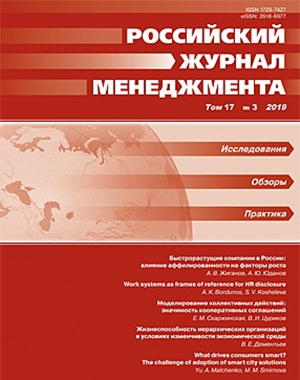Жизнеспособность иерархических организаций в условиях изменчивости экономической среды
DOI:
https://doi.org/10.21638/spbu18.2019.304Аннотация
В статье рассматриваются факторы, ограничивающие трансформацию крупных компаний в сетевые организации. Отмечается, что данные организации часто обладают иерархическими качествами, проявляющимися в субординации партнеров по сети. Центральное место в работе занимает анализ влияния изменчивости экономической среды на рациональное соотношение централизации и децентрализации в координации экономической деятельности. При сопоставлении организационных структур динамические качества экономической среды сначала принимаются фиксированными, а затем меняющимися. Показано, что децентрализация не является универсальным ответом на изменчивость экономической среды. Однако сочетание элементов иерархических и сетевых отношений в рамках крупных фирм способствует их приспособлению к меняющимся динамическим качествам среды. Такое сочетание помогает диверсификации бизнеса и переходу к формированию новых рынков вместо только адаптации к рыночной конъюнктуре. Представлены организационные меры компаний, реализующих стратегию «голубого океана».
Ключевые слова:
цифровая экономика, инновации, иерархические организации, сетевые организации, централизация, децентрализация, технологическая революция
Скачивания
Библиографические ссылки
REFERENCES IN LATIN ALPHABET
Translation of references in Russian into English
Загрузки
Опубликован
Как цитировать
Выпуск
Раздел
Лицензия
Статьи журнала «Российский журнал менеджмента» находятся в открытом доступе и распространяются в соответствии с условиями Лицензионного Договора с Санкт-Петербургским государственным университетом, который бесплатно предоставляет авторам неограниченное распространение и самостоятельное архивирование.





